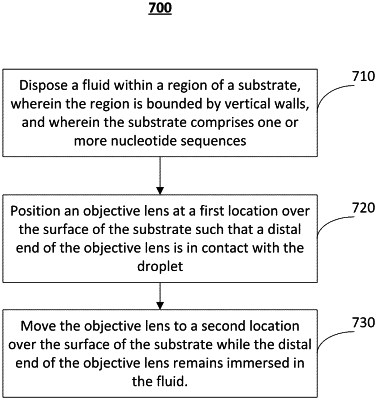| CPC G02B 21/008 (2013.01) [G02B 21/0036 (2013.01); G02B 21/02 (2013.01); G02B 21/24 (2013.01); G02B 21/33 (2013.01)] | 21 Claims |

|
1. An optical imaging system for nucleic acid sequencing, the system comprising:
an actuator;
a substrate, wherein the substrate comprises vertical walls bounding a region of the substrate, the vertical walls being configured to retain a fluid within the region, and wherein the substrate comprises one or more nucleic acid sequences; and
an objective comprising a proximal end and a distal end, wherein the proximal end of the objective is coupled to the actuator and the distal end of the objective is configured to be near an exterior surface of the substrate, wherein the distal end of the objective is configured to be immersed in the fluid;
wherein the actuator is configured to move the objective from a first location over the exterior surface of the substrate to a second location over the exterior surface of the substrate while the distal end of the objective remains immersed in the fluid;
further comprising a fluid monitoring subsystem for determining whether a portion of the fluid has evaporated from the region, wherein the fluid monitoring system comprises an optical sensor for detecting a presence of air bubbles in the fluid, and wherein determining whether a portion of the fluid has evaporated from the region comprises determining whether a threshold number of air bubbles are detected in the fluid.
|